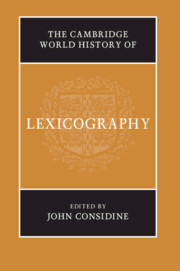Book contents
- The Cambridge World History of Lexicography
- The Cambridge World History of Lexicography
- Copyright page
- Contents
- Contributors
- Editor’s Acknowledgements
- Introduction
- Part I The Ancient World
- Part II The Pre-Modern World
- 6 China, c. 600–c. 1700
- 7 India and Tibet, c. 500–c. 1750
- 8 Arabic to c. 1800
- 9 Hebrew to c. 1650
- 10 The Chinese Periphery to c. 1800
- 11 The Turkic Languages and Persian to c. 1700
- 12 Byzantine Greek
- 13 Medieval Latin Christendom
- 14 Early Modern Western and Central Europe
- Part III The Modern World: Continuing Traditions
- Part IV The Modern World: Missionary and Subsequent Traditions
- Appendix 1 The Language Varieties
- Appendix 2 The Lexicographers
- Primary Sources
- Secondary Sources
- Index
10 - The Chinese Periphery to c. 1800
from Part II - The Pre-Modern World
Published online by Cambridge University Press: 01 September 2019
- The Cambridge World History of Lexicography
- The Cambridge World History of Lexicography
- Copyright page
- Contents
- Contributors
- Editor’s Acknowledgements
- Introduction
- Part I The Ancient World
- Part II The Pre-Modern World
- 6 China, c. 600–c. 1700
- 7 India and Tibet, c. 500–c. 1750
- 8 Arabic to c. 1800
- 9 Hebrew to c. 1650
- 10 The Chinese Periphery to c. 1800
- 11 The Turkic Languages and Persian to c. 1700
- 12 Byzantine Greek
- 13 Medieval Latin Christendom
- 14 Early Modern Western and Central Europe
- Part III The Modern World: Continuing Traditions
- Part IV The Modern World: Missionary and Subsequent Traditions
- Appendix 1 The Language Varieties
- Appendix 2 The Lexicographers
- Primary Sources
- Secondary Sources
- Index
Summary
This chapter will treat the lexicographies of eastern Inner Asia, Japan, and Korea that were directly influenced by the Chinese tradition. The first section will begin by discussing lexicography in the Inner Asian empires in the early second millennium AD, with a focus on the lexicography of the Tangut and Mongols in North China; and will then turn to the lexicography of Inner Asian languages in the Chinese Míng empire that succeeded the period of Inner Asian political dominance in North China; and finally to the lexicography of Manchu and Mongolian in the Inner Asian Qīng empire, which conquered the Míng and ruled from Beijing. The remaining two sections of the chapter will treat lexicography in Japan and Korea.
- Type
- Chapter
- Information
- The Cambridge World History of Lexicography , pp. 202 - 222Publisher: Cambridge University PressPrint publication year: 2019

